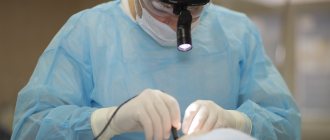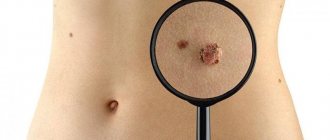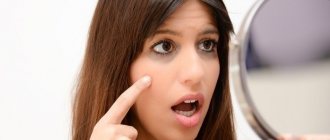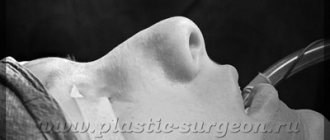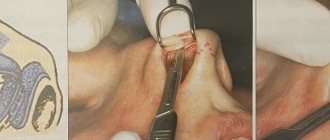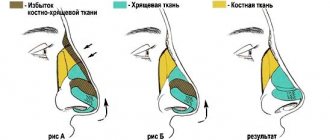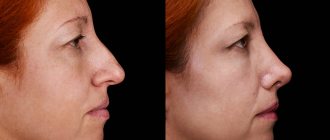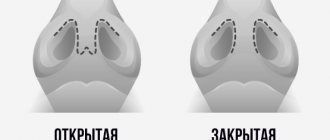Contour plastic surgery is a truly magical procedure that instantly relieves women of age-related skin changes and other imperfections. The Omsk LINE LIFE Medical Center employs professional cosmetologists who will select the most effective drug just for you and get rid of the problem without anesthesia, incisions, and literally in an hour.
For contour plastic surgery, we use both “classical” drugs and the latest world discoveries: Surgiderm. Juvederm, Teosial.
The duration of the procedure is no more than 30 minutes. The cosmetic effect will last from six months to a year.
Types of nose surgery
First of all, there is a distinction between closed and open rhinoplasty:
- The closed type involves the surgeon performing all manipulations inside the nose, without external incisions. Endoscopes are often used for such procedures. This type of plastic surgery is indicated for eliminating minor defects or mild shape correction.
- Open rhinoplasty involves working on the osteochondral part of the nose after exposing the tissue using an incision across the nasal septum. Such interventions are carried out to correct complex deformities and remove a pronounced hump. After completion, cosmetic stitches are applied to the skin, and the new shape of the nose is fixed with plaster.
Rhinoplasty is also divided into reconstructive and modeling. In the first case, the goal is to restore the shape, appearance and function of the nose after injury, disease and other lesions. In the second, the intervention is carried out at the request of the patient to improve the aesthetics of the profile.
Primary and secondary rhinoplasty can be noted:
- The primary one is carried out after the patient’s first visit to a plastic surgeon. This could be the elimination of cosmetic defects or the treatment of breathing problems.
- Secondary plastic surgery involves correcting the unsatisfactory consequences of previous operations. This is the most difficult type of rhinoplasty, requiring the highest professionalism, experience, and skill from the doctor.
Plastic surgeons at the STATUS re-age clinic perform any type of nose correction with high quality.
Rhinoplasty. What will your nose tell you?
Aesthetic dissatisfaction with appearance can greatly influence a person’s self-esteem, especially when it comes to the face. The consequences of youth trauma and the peculiarities of individual development lead to imperfections in the shape of the nose, which becomes far from the canons of beauty. A plastic surgeon knows how to remove a hump, correct the tip of the nose, correct wide nostrils, or generally change the shape. But to get a decent result, you need to approach the issue comprehensively, and now we will analyze in detail why.
Preparing for surgery
Rhinoplasty is a serious surgical intervention that involves a surgeon working with a vital organ of the human body. The nose consists mainly of cartilage tissue, but it has many blood vessels. If the surgeon touches or damages one of them, the patient will have breathing problems for the rest of his life. Therefore, before we begin examining the patient, we methodically clarify his expectations and draw up a 3D visualization of the future profile. During the operation, the doctor will try to perform the correction so that the result matches the visualization as closely as possible, while maintaining respiratory function and nasal health.
As before any surgical intervention, you will have to undergo a comprehensive examination and tests.
Contraindications for rhinoplasty:
- Diabetes;
- Infectious diseases in the acute stage;
- Heart diseases;
- Liver pathologies;
- Oncological and immune diseases;
- Bleeding disorders;
- Pregnancy and lactation.
How is the procedure performed?
Contour plastic surgery is a non-surgical method of correcting the face and body by introducing injectable filler preparations, conventionally called “gels,” into the superficial, middle or deep layers of the skin, as well as implants.
Today in Russia the use of more than 50 types of various fillers is permitted. The drugs are injected into the tissue using a syringe, straightening the folds of the skin and pushing out the bottom of the wrinkles. The procedure is performed on an outpatient basis.
After administering the drug under the skin:
- There may be slight redness at the injection site, swelling and slight itching.
- In the first days, we recommend not to drink alcohol, not to visit the sauna and bathhouse, and to refrain from taking antibiotics.
Who should not have contour plastic surgery?
You should not use this procedure in the following cases:
- the presence of infectious, viral, oncological diseases
- if silicone was previously injected
- if there is an inflammatory process in the affected area
- pregnancy and lactation
Drugs
The choice of drug will, of course, be made by the doctor; it will be based on your individuality and specific case, but you should know which drugs are most effective today.
Hyaluronic acid is the safest
This is what most cosmetologists think, and not without reason, because it is on its basis that the most effective drugs are produced.
This product is completely compatible with the skin, has low rates of complications, and finally, the effect of use will be noticeable almost immediately after administration.
Pros of hyaluronic acid:
- fills wrinkles
- prevents skin aging by maintaining moisture levels in it
- absolutely safe, which cannot always be said about synthetic fillers
- does not cause allergies
- completely eliminated from the body
Do you want more effective results? Then discuss with your doctor the combination of contouring with Botox or Dysport injections.
Why is hyaluronic acid used?
Over the years and under the influence of various unfavorable external factors, our skin reduces its ability to retain moisture, its architecture is disrupted and, as a result, metabolic processes slow down, the skin begins to age, losing its former elasticity, wrinkles and folds appear.
Hyaluronic acid is an essential component in our body, which helps retain moisture in the dermis, and collagen ensures the strength and elasticity of the skin. That is why contour plastic surgery is simply impossible without preparations based on collagen and hyaluronic acid, since they are a natural building material that does not cause rejection by the body or allergic reactions.
What is the effectiveness of hyaluronic acid?
- restores skin elasticity,
- improves cell activity,
- enhances metabolic processes,
- normalizes tissue respiration of the skin.
When introduced into the dermis, hyaluronic acid “fills” the skin from the inside - wrinkles and folds are evened out. The effect of such contouring lasts for many months due to the fact that these drugs remain in the body and retain water around them.
Radiesse
Radiesse is another popular and effective filler based on calcium hydroxylapatite. It is also used for non-surgical face lifting and as a longer-term wrinkle correction. The main feature of Radiesse is that it acts as a filler and stimulates the body's production of collagen.
Differences from preparations based on hyaluronic acid
Radiesse is able to maintain the effect of correction for a longer period than hyaluronic acid. The results of the procedure will please you for 15 months or more.
The drug is absolutely safe and has been well studied, you don’t have to worry about consequences in the form of inflammatory reactions - there won’t be any. After a few months, Radiesse is 100% eliminated from the body.
Cosmetologists are convinced that if you want to look younger, it is not enough to get rid of wrinkles, you must not forget about clear facial contours, volume, symmetrical cheekbones, dense elastic skin - all this is lost with age along with collagen production. And, as a result, the skin looks older, regardless of whether there are wrinkles or not.
Pros of Radiesse:
Radiesse restores youth in the full sense of the word, replenishing lost volume and smoothing out wrinkles, tightening the skin and correcting the oval of the face.
With Radiesse, contouring has gained a lot and allowed:
- restore volume in the cheekbones and cheeks,
- rejuvenate the hands,
- carry out non-surgical rhinoplasty, that is, correction of the bridge of the nose,
- correct the oval of the face and chin,
- rid the appearance of nasolabial folds and wrinkles in the corners of the mouth.
So, contour plastic surgery will allow ladies to finally get rid of hated wrinkles, both deep and fine facial wrinkles, correct the oval of the face and other parts of it, give additional volume to the lips and rejuvenate women’s hands, but before you decide on the drug yourself, be sure to consult with a doctor at the LINE LIFE clinic!
Make an appointment or consultation: +7 (3812) 21-11-67, +7 (913) 657-24-44
How is the operation performed?
Rhinoplasty requires hospitalization. It is usually performed under general anesthesia. In our clinic we use high-quality, expensive, modern drugs for pain relief and sedation, which have minimal side effects. After them, patients do not suffer from dizziness, disorientation, or memory loss.
Time in the operating room ranges from 2 to 6 and even 10 hours in complex cases. In addition to rhinoplasty itself, the patient may require septoplasty - correction of the nasal septum to eliminate breathing problems. Or rhinoseptoplasty – correction of the shape of the nose and correction of the nasal septum.
When reducing the nasal hump, we often use a piezo apparatus - equipment for working with bones, which reduces the duration of the intervention and the risks for the patient.
Otorhinolaryngologist
A doctor - an otorhinolaryngologist (ENT) - deals with the diagnosis, treatment and prevention of diseases of the ENT organs (ear, nose and throat).
Symptoms that require consultation with an ENT doctor - otorhinolaryngologist:
- A sore throat
- Difficulty, painful swallowing
- Nasal discharge
- Difficulty in nasal breathing
- Itchy nose, sneezing
- Decreased sense of smell
- Ear pain, foreign body sensation
- Hearing loss
- Feelings of ear fullness
- Discharge from the ear
- Injury to the ear, throat, or nose
- Neoplasms of ENT organs
- Noise in ears
- Hoarseness (hoarseness) of the voice
- Swallowing disorders
Many symptoms of diseases of the ENT organs can be accompanied by headache, fever, inflammation and soreness of the lymph nodes. It is very important to promptly contact a specialist - an otolaryngologist in order to cope with the disease as quickly and effectively as possible. In addition, many diseases of the ENT organs that have not been properly treated can take a chronic form (chronic rhinitis, tonsillitis, etc.). In this case, the entire body is exposed to intoxication from a constant source of inflammation, and the person is more susceptible to the influence of respiratory infections. Diseases of ENT organs often cause complications.
The most common diseases of ENT organs:
- Tonsillitis
- Laryngitis (acute, chronic)
- Chronic pharyngitis
- Angina
- Chronic rhinosinusitis
- Chronic rhinitis
- Allergic rhinitis
- Sinusitis
- Deviated nasal septum
- Nasal polyps
- Otitis
- Tubootitis
- Boils (ear, nose)
- Sensorineural hearing loss
- Benign neoplasms
- Malignant neoplasms
At the initial consultation, the ENT doctor carefully listens to the patient’s complaints and conducts an endoscopic examination. If necessary, a swab is taken from the ear, nose or larynx.
During the consultation, the otolaryngologist can treat the ENT organs with medications, rinse the lacunae of the tonsils and other medical procedures.
Diagnosis of diseases of the ENT organs (additional studies that may be prescribed by an otolaryngologist during consultation):
- Endoscopic diagnostics (rhinoscopy, otoscopy, pharyngoscopy, direct laryngoscopy)
- X-ray diagnostics (for example, radiography or computed tomography of the paranasal sinuses)
- Pure-tone audiometry
- Laboratory diagnostics
- Tympanometry
Treatment can be conservative or surgical. Conservative treatment includes medications and various procedures:
- Puncture of the maxillary sinuses
- Washing of tonsil lacunae (vacuum lavage of lacunae)
- Vacuum displacement method for rinsing the paranasal sinuses
- Applications or lubrication of medicinal substances to the mucous membranes of the ENT organs
- Cauterization of mucous membranes of ENT organs with medicinal substances
- Eustachian tube catheterization
- Politzer blowing
- Pneumomassage of eardrums
- Rinsing the ear with medicinal substances
- Intralaryngeal infusions
- And others
As surgical methods of treatment, an ENT doctor performs such interventions as disintegration of the inferior turbinates using electrosurgical devices, endoscopic nasal polypotomy (removal of nasal polyps), removal of papillomas, etc.
Treatment of ENT diseases at the Central Clinical Hospital
The otolaryngology office is equipped with modern equipment that provides the opportunity to conduct a detailed examination of ENT organs using an endoscope and microscope, carry out therapeutic procedures, as well as electrosurgical operations, incl. in a day hospital setting. Patients are treated using modern techniques and advances in pharmacology. The patient is offered a full range of outpatient services for the diagnosis, treatment and prevention of ENT diseases: puncture of the maxillary sinuses, washing them through the anastomosis, washing using the displacement method, instillation therapy is widely used, complex treatment of chronic tonsillitis is carried out, including washing of the tonsils using vacuum aspiration. Before carrying out treatment, an ENT doctor examines the flora causing the pathological process, as well as its sensitivity to drugs. In case of ear disease, a hearing test is carried out, restoration of the function of the auditory tubes (blowing, catheterization with the administration of drugs), washing of the attic, sanitation of the cavity after radical surgery on the ear. Therapeutic and surgical methods are used to stop nosebleeds, and foreign bodies are removed from the nose, pharynx, larynx, and ear.
Rehabilitation
After plastic surgery, the nasal passages are sealed for 1 or 2 days, so you will have to endure some breathing through your mouth. You can go home the next day; the exact time for removing the bandage will be determined by your doctor. This usually happens on day 8-10. Swelling and bruising will go away within a month. The result of the intervention will be assessed no earlier than after 2 months.
During the rehabilitation period, you will need to visit a physiotherapist, follow caution and all additional recommendations from the surgeon.
Call our clinic to find out the approximate cost of rhinoplasty and make an appointment for a consultation.
Restrictions
After rhinoplasty it is strictly prohibited:
- remove the turundas yourself;
- sleep on the nose;
- visit the pool for 2 months;
- heavy physical activity;
- severe nose blowing for 2 months;
- remove, move, adjust the plaster splint - if it begins to come off or completely falls off, it is strictly forbidden to put it in place, squeezing and trying to fix it; if traces of compression or removal of the nasal splint are detected, the surgeon completely declines responsibility for the result;
- pull out and trim threads;
- use drugs, procedures, take medications that the doctor did not prescribe; self-medicate;
- do peelings, cleansing, sunbathing for 3 months, any cosmetic procedures on the skin of the nose for 3 months.


